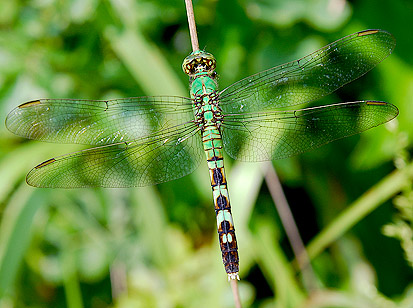Hawkins Road, Vincentown, NJ
Phone: (609) 984-1339
nj.gov/dep/njnlt/bearswamp.htm
New Jersey Natural Lands Trust
Exit Medford Park via Gill Road and turn Right on Allen Avenue. Turn Right again on Main street, and then Left onto Chapel Avenue. After 0.5 miles Chapel Avenue Bears Left to become Branin Road. Proceed on Branin Road for another 0.5 miles, and turn Right on Chairville Road. After 0.3 miles bear Right onto Hawkin Road. After 2.5 miles Hawkin Road will pass under some high-tension wires. 0.5 miles beyond this, look to your right for a trailhead and signs for the preserve, just before crossing a small wooden bridge. DIRECTIONS FROM NEAREST HIGHWAY: From the Intersection of Route 206 and Route 70, proceed South on Route 206. After 1.7 miles, turn Right onto Hawkin Road. After 1.2 miles, cross a short wooden bridge and look for the sign for the reserve on the Left side of the road. Map
 |
| Eastern Pond Hawk | Bill Lynch |
| |
| | This reserve is recognized by New Jersey Audubon as an Important Bird Area, and offers a wide range of habitats. Pitch-pine lowlands and Atlantic white cedar swamps are joined by remnant cranberry bogs. A sand road near the sign offers shrub habitat and great views of many insects, including butterflies and dragonflies.
The trail close to the bridge leads to a stream that hosts Prothonotary Warbler nest boxes. These brightly colored birds have utilized the boxes and are most easily spotted during the spring months.
Wintering bird species include Long-eared Owls, Northern Harriers, Bald Eagles, Sharp-shinned and Red-shouldered hawks, American Woodcock, Hairy Woodpecker, Brown Creeper, and Northern Flicker. Deer and cottontail rabbit are abundant, and red or gray fox can occasionally be glimpsed.
Hooded, Magnolia, Chestnut-sided, and many other warbler species and migrating songbirds will be moving through. Breeding birds such as Eastern Wood Pewee and Gray Catbird will be singing and most visible during these months. Listen for the descending chirps of the elusive Kentucky Warbler, and the tweet tweet tweet tweet of the Prothonotary Warbler in wet woodlands. Snakes, lizards, salamanders, frogs, and toads are abundant and often conspicuous in the spring and summer.
Resident birds of interest include Scarlet Tanager, Black-billed Cuckoo and Acadian Flycatcher. Listen around dusk for the incessant echo of Whip-Poor-Will in the woods. Narrow trails will be less than comfortable during the summer months when they become overgrown and quite buggy. Try walking the wider roads under the power-line cut, where butterflies and dragonflies will be abundant. Indigo Bunting, Orchard Oriole, White-eyed Vireo, Blue-gray Gnatcatcher, and Common Yellowthroat can be found here as well. Insect repellent is a priority.
The second round of migration should again produce many species moving through the area, as well as breeders who hang around through the beginning of the fall season. Look for Brown Thrasher, Eastern Towhee, Palm, Prairie, and Yellow-rumped Warbler, to name a few.
|